|
|
สวนป่าหิมวันต์ The Middle way
สวนป่าหิมวันต์ &"THE Middle WAY"
//news.dmc.tv/ข่าว/ข่าวประชาสัมพันธ์-61.html
สวนป่าหิมวันต์ เป็นสถานที่ปฏิบัติธรรมทางภาคอีสานตอนบน ตั้งอยู่ในหมู่บ้านแก่ง ตำบลร่องจิก อำเภอภูเรือ จังหวัดเลย คำว่า แก่ง หมายถึงลำน้ำใสเย็นล่องผ่านขุนเขา คือความโดดเด่นเป็นเอกลักษณ์ของสวนป่าหิมวันต์แห่งนี้ ดินแดนที่หากใครได้มาเยือนต่างพูดเป็นเสียงเดียวกันว่าต้องมนต์เสน่ห์เมืองทะเลหมอก ดอกไม้งาม บานสะพรั่งทั้งภูเรือ ที่ไม่อาจลืมเลือนไปจากความทรงจำ

บริเวณกว้างขวางของสวนป่าหิมวันต์นับพันไร่ ตั้งอยู่ท่ามกลางพื้นที่ป่าภูเรือ ด้วยความสูงกว่าระดับน้ำทะเลถึง 900 เมตร อุณหภูมิเฉลี่ย 5 - 25 องศาเซลเซียส ซึ่งประกอบด้วยทิวเขาสูงซับซ้อนเรียงรายเป็นรูปต่างๆอย่างน่าพิศวง สลับกับที่ราบเป็นบางส่วน จึงเรียกขานกันว่า "ภูเรือ" เพราะบนยอดเขาสูงทอดลงสู่ที่ราบกลางหุบเขาลักษณะคล้ายท้องเรือ ตลอดจนมีธรรมชาติและทิวทัศน์เมืองหนาวที่สวยงาม สามารถมองเห็นได้รอบทิศทาง 360 องศา

นอกจากนี้ สวนป่าหิมวันต์มีสถานที่พักเป็นส่วนตัว เรียกว่า บ้านรังนก เหมาะสำหรับการปลีกวิเวก เพื่อเจริญจิตภาวนาอย่างสงบสันโดษ และห้องปฎิบัติธรรมกว้างขวาง สามารถรองรับสมาชิกได้ถึง 200 คน อิ่มอร่อยกับเมนูอาหารธรรมชาติที่หาได้เฉพาะท้องถิ่น ผักสดปลอดสารพิษที่ปลูกได้เองตลอดทั้งปี ผลไม้เมืองหนาวนานาชนิด ทั้งเสาวรถสีเหลืองทอง และแก้วมังกรสีสดใสให้คุณได้แวะชิมแวะชมอย่างอิ่มหนำ
ยามเช้า ต้นไม้ใบหญ้าจะถูกปกคลุมด้วยฝ้าขาวของละอองน้ำ และสายหมอกบนเนินเขาสูงของสวนป่าหิมวันต์ จะพบต้นจันทน์ผาขนาดใหญ่ขึ้นแซมสลับซ้อน จัดอยู่ในพืชป่าสงวนแห่งชาติอายุนับร้อยปี ที่หาชมได้ยากมาก
กิจกรรมclick

ทำไมต้องฝึกสมาธิ
วันเวลาเป็นสิ่งที่หามาได้โดยง่าย
ผ่านพ้นไปเร็ว และเรียกกลับคืนมาไม่ได้
วันหนึ่งคืนหนึ่งจะมีคุณค่ามากน้อยเพียงใด
มีวิธีวัดง่ายๆ คือ วัดที่ความสุขกายและสุขใจ
แต่การแสวงหาความสุขในภาวะสังคมปัจจุบัน
ไม่ใช่เรื่องง่าย ความล้ำหน้าทางเทคโนโลยี
เข้ามามีบทบาทในชีวิตประจำวันมากขึ้น
ทุกสังคมต่างยื้อแย่งแข่งขันให้ได้มา
ความเจริญทางด้านวัตถุ
ซึ่งจะนับเป็นอัตราส่วนแปรผกผันกับการเจริญทางด้านจิตใจ
ให้ลดน้อยลงไปทุกที
เพราะขณะที่โลกหมุนไป
ประหนึ่งว่านำความทุกข์ เซ็ง เครียด เบื่อ
เรื่องราวต่างๆถาโถมเข้ามารุมเร้าไม่หยุดหย่อน
แล้วความสุขที่แท้จริงนั้นอยู่ที่ไหน มีลักษณะอย่างไร จะสามารถเข้าถึงด้วยวิธีการใด คือคำถามที่ใครๆพยายามค้นหาคำตอบ ทั้งบ้าน รถ เงินทอง ชื่อเสียงเกียรติยศ หรือการเข้าไปนั่งอยู่ในใจคนที่รัก...คือความสุขที่แท้จริงใช่หรือไม่
หลายคนเดินทางไปถึงเป้าหมายตั้งแต่ต้น แต่คำตอบที่ได้ คือ ยังไม่ใช่ คนไม่น้อยแม้มีเงินร้อยล้านก็ยังไม่มีความสุข ดิ้นรนค้นหาไม่หยุดหย่อน ไม่สามารถแยกแยะได้ว่าอะไรคือความอยาก อะไรคือความต้องการ อะไรคือความจำเป็นที่ขาดไม่ได้ หรือขาดได้ ปล่อยให้ใจดวงนี้อยู่ในภาวะไร้การควบคุมต้องตกเป็นทาสอารมณ์ที่ถมไม่เต็มอยู่เสมอ และนี่คือสาเหตุ ว่าทำไมเราต้องทนทุกข์อยู่ร่ำไป
ทั้งนี้เพราะการกระทำต่างๆไม่ว่าดีหรือร้าย ล้วนเป็นผลมาจากความคิดทั้งสิ้น ใจของเราจึงเป็นสิ่งที่ควรถูกพัฒนาเป็นอันดับแรก ด้วยถือเป็นทรัพยากรอย่างเดียวในตัวมนุษย์ที่ทรงคุณค่าที่สุด แต่เป็นธรรมดาว่าใจนี้มีปกติขึ้นลงไม่คงที่ การที่จะสามารถรักษาความดีให้มั่นคงได้ ไม่มีอะไรเทียบเท่า
สวนป่าหิมวันต์ ภูเรือ จ.เลย 3-9 กพ 2551
โครงการดอกไม้บานรุ่นที่ 319
ขึ้นรถไป ภูเรือ
จากวัดพระธรรมกาย ประมาณ 6 ชั่วโมง

ถึงแล้วคะ
ภายในบ้านพัก หลังเล็ก 1 หลังมี 2 ห้อง มีกรอบรูปด้วย อากาศ โปร่งโล่ง เย็นสบายมาก
มีสิ่งอำนวยความสะดวกครบ คือ ปลั๊กไฟ พัดลม ไม้กวาด
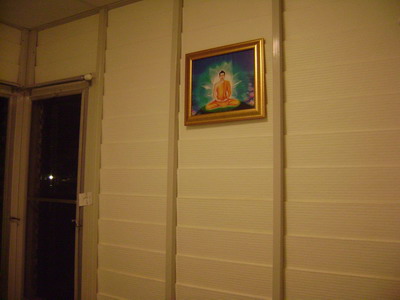
บ้านพักชาย บ้านเดี่ยว
หนึ่งคนต่อ หนึงหลัง

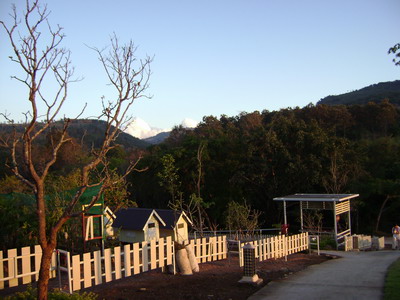
ห้องประชุม ฟังธรรม นั่งสมาธิ
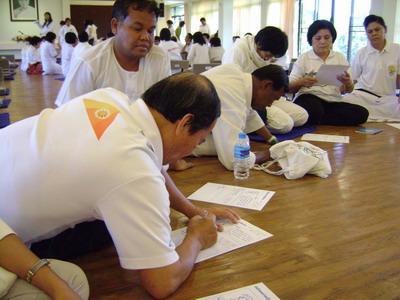
วิวบนเขา


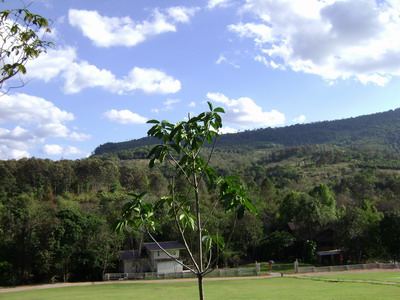
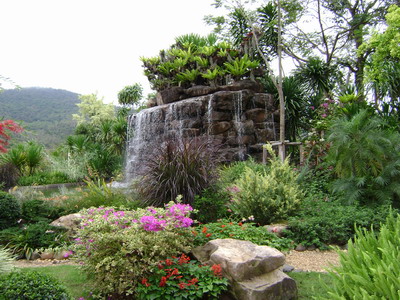


---------------------------------------------------------
ภาพศูนย์กลางกายฐานที่7
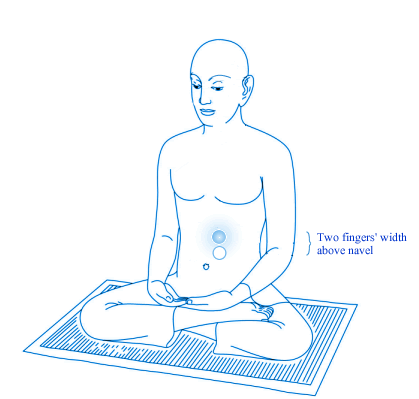
Meditate for beginners
(and sceptical Westerners)
Introduction
Now that Buddhism is such a fast-growing religion in the West, a lot of Westerners are attracted to its rational approach and rejection of an all-powerful deity. But all too often we Westerners quickly get stuck on the idea of rebirth and the various cultural traditions that have become a part of Buddhism in Asia.
I've been there myself - wondering if rebirth is for real, if karma is scientific, if Buddhism is rational, why I have to bow to a statue, and so on - and I almost gave up at one point. I've noticed also that some Westerners pop up on the Internet looking for others who've converted to Buddhism, hoping they can discover the trick to becoming a Buddhist despite a materialist upbringing.
So this page is a mixture of useful resources and my own personal experiences in fully accepting Dharma as a way of life. I hope it will be of some use to others on the same path.
Where should I start?
What is Buddhism?
Are rebirth and karma for real?
What is our purpose in life?
What's the difference between Theravada and Mahayana?
Which tradition should I choose?
How do I become a Buddhist?
Which are good books to read?
Where should I start?
If there's one place you should not start, it's reincarnation/rebirth. Newcomers to Buddhism tend to open every book at the section on rebirth because what happens to us after we die is all-important in the monotheistic culture we come from.
But the Buddha wasn't teaching rebirth as the goal of life. He said many times, "I teach suffering, and the way out of suffering." That was his message, to make nirvana (Pali: nibbana) - the end of suffering - the goal. So the place to start is with the basics, the Four Noble Truths and a practice aimed at reducing suffering. If this seems worthwhile to you, you're on your way.
In fact, the best way to start is by doing a lot of reading. You need to know about the basic principles of Buddhism, its founder, its history, the different traditions, and what it can do for you. Even though there's a lot of stuff available free on the Internet, I still think a well-written book is the best way to go. For all of the above, try John Snelling's The Buddhist Handbook : A Complete Guide to Buddhist Schools, Teaching, Practice, and History or Gill Farrer-Halls' The Illustrated Encyclopedia of Buddhist Wisdom (which is also a handbook). These two books are both excellent primers to start off with. There's also a short overview titled What is Buddhism? from the Buddhist Society of Western Australia.
For inspiring books written by Western monks who really understand Westerners' problems, try Ajahn Sumedho's The Mind and the Way : Buddhist Reflections of Life or Ajahn Jagaro's True Freedom, which is available online:
Chapter 1: True Freedom
Chapter 2: Compassion - The Natural Expression of Awakening
Chapter 3: Buddhism and God
Chapter 4: Beyond Boredom and Depression
Chapter 5: Buddhism and Vegetarianism
Chapter 6: Death and Dying
Another book that's a must-read is Thich Nhat Hanh's little-known masterpiece, Old Path, White Clouds : Walking in the Footsteps of the Buddha, a beautiful and easy-to-read story of the Buddha's life drawn from accounts in the Pali Canon and illustrated with line drawings.
For a thorough explanation of the nuts and bolts of the teachings and practice, check out Ayya Khema's Being Nobody, Going Nowhere : Meditations on the Buddhist Path (very good at showing how ego rules our lives) or Henepola Gunaratana's Eight Mindful Steps to Happiness : Walking the Buddha's Path.
There are a lot of good books on Dharma (Pali: Dhamma), but I'd recommend starting of with the original Theravada Buddhism and checking out the Mahayana traditions like Zen and Tibetan when you have a grasp of the basics. What you read will depend on what particular problems brought you to Buddhism in the first place. Some authors, the Dalai Lama and Thich Nhat Hanh, for example, have written books on anger management.
But it's important to practise too. In addition to following the Five Precepts, try practising Right Speech, generosity, compassion, being less self-centred, being less addicted to pleasures of the senses and being less concerned with possessions. And once you have a good grasp of the basic teachings and different traditions, it will be time to start meditating.
Your situation in life may affect your practice and progress. If you live near a temple or Buddhist group, you'll be able to listen to Dharma talks, make Dharma friends and be with a community of like-minded people. If you don't, there are always the Internet and Buddhist forums such as E-Sangha and the Buddhist Society of Western Australia.
I personally live in a Buddhist country where the majority of people don't understand the deeper teachings of Buddhism, so their focus is on making merit for a better rebirth and participating in ceremonies. So I rely a lot on the Internet, on Amazon and a few friends. I rarely go to temples.
What is Buddhism?
The following article is from the website of the Buddhist Society of Western Australia. The author explains karma and rebirth in the traditionally accepted way and is somewhat sceptical about the origins of the Mahayana sutras, but otherwise it's an excellent overview of Buddhism.
Introduction
For more than 2,500 years, the religion we know today as Buddhism has been the primary inspiration behind many successful civilizations, the source of great cultural achievements and a lasting and meaningful guide to the very purpose of life for millions of people. Today, large numbers of men and women from diverse backgrounds throughout our world are following the Teachings of the Buddha. So who was the Buddha and what are His Teachings?
The Buddha
The man who was to become the Buddha was born Siddhattha Gotama around 2,600 years ago as a Prince of a small territory near what is now the Indian-Nepalese border. Though he was raised in splendid comfort, enjoying aristocratic status, no amount of material pleasure could satisify the enquiring and philosophic nature of the young man. At the age of 29 he left palace and family to search for a deeper meaning in the secluded forests and remote mountains of North-East India. He studied under the wisest religious teachers and philosophers of his time, learning all they had to offer, but he found it was not enough. He then struggled alone with the path of self- mortification, taking that practice to the extremes of asceticism, but still to no avail.
Then, at the age of 35, on the full moon night of May, he sat beneath the branches of what is now known as the Bodhi Tree, in a secluded grove by the banks of the river Neranjara, and developed his mind in deep but luminous, tranquil meditation. Using the extraordinary clarity of such a mind with its sharp penetrative power generated by states of deep inner stillness, he turned his attention to investigate upon the hidden meanings of mind, universe and life. Thus he gained the supreme Enlightenment experience and from that time on he was known as the Buddha. His Enlightenment consisted of the most profound and all-embracing insight into the nature of mind and all phenomena. This Enlightenment was not a revelation from some divine being, but a discovery made by Himself and based on the deepest level of meditation and the clearest experience of the mind. It meant that He was no longer subject to craving, ill-will and delusion but was free from their shackles, having attained the complete ending of all forms of inner suffering and acquired unshakeable peace
MEDITATION IS GOOD FOR EVERYONE.
Emotional pain and discomfort is something none of us can avoidregardless of our age, social background and religious belief. While we cannot prevent death, illnesses, rejection, separation and a host of other unwanted events, we can also strengthen our mind with regular practice of meditation so that it is less susceptible to pains brought by all these uncontrollable events.
This does not mean that meditation will harden your mind so that you become a heartless person. Rather, it cleanses the mind so that regular Dhammakaya meditators become calmer, gentler, kinder and feel increasingly uncomfortable about harming anyone either by speech or action.
The village chooses to provide lessons on the Dhammakaya meditation as it is the only technique in the world that teaches about the center of the body as the natural home of the human mind and an unlimited source of joy.
Many have found regular practice of this meditation method helped them overcome physical ailments and emotional illnesses. Others have expressed satisfaction at increased self-esteem, better work performance, and improved relationships with colleagues and family members.
Whether you are happy or sad, looking for the real meaning of life, or wishing to discover more about yourself, the Dhammakaya meditation has the answer for you
MEDITATION FOR BEGINNERS :
Sit cross-legged with your right leg on your left leg and your right hand on your left hand. If you find this position uncomfortable, you can sit on a cushion or a chair. In any case, your right index should touch your left thumb. Close your eyes very gently as if you are about to sleep. Empty your mind of all kinds of thoughts. Breathe in deeply and gently exhale a few times. Relax every muscle in your body.

Imagine that the inside of your body is hollow as wellwith no internal organs. Rest your mind at the center of the body, which is located inside at the level of two fingers width above the navel.

If you find it hard to bring attention to the center of the body, you can rest your mind elsewhere inside the body where you feel most comfortable. Calmly and silently observe whatever image that arises-- whether it is darkness or bright light or anything else, just accept it without any thought.
When resting your mind at the center of the body or anywhere else inside the body, make sure not to strain the eyes. In meditation, we see with the mind, not with the physical eyes; thats why we close them.
If your mind wanders, you can use visualization to help keep your mind still. To do so, imagine that a crystal ball is floating in the middle of your stomach. You can use other neutral objects that youre familiar with such as an orange, a football or the moon. You can also repeat the mantra Summa Arahung which means virtuous path, away from impurities of the mind.
ิ
Continue to rest mind at the center of the body and make no judgment or emotional response to whatever you experience. For beginners, we suggest that you practice meditation for 15 to 30 minutes in the morning and near the bedtime, and increase the length of time, say up to one hour, as you feel more comfortable.
Depending on the degree of stillness and clarity of your mind, after a while you will experience a sense of peacefulness and refreshing joy as if youve just come out of an inner spa.
If you feel tense afterwards, chances are you might be trying too hard. Open your eyes, adjust your sitting position until you feel comfortable, and start over again.
If you feel asleep, perhaps you need to focus more on the center of the body. Take a few deep breaths and silently repeat the mantra summa arahung. If sleepiness persists, perhaps you are physically tired, just allow yourself to doze off a bit before starting over again.
Stilling the mind is an art, and key to mastering the Dhammakaya meditation. There are many other ways to still the mind, which suit different individuals for different reasons. If you would like to explore other alternatives in detail, wed suggest that you come to learn meditation and receive personalized guidance that best fits your unique character from experienced teaching monks at our village
Lets Meditate
Lets give ourselves a try. Firstly we must know the real nature of the mind. It is bright, clear and in the sphere form like a tiny crystal ball. Normally, the mind always wanders around. Lets close the eyes and imagine that we bring the wandering mind to stop at the nostril, male is at the right, female at the left. The nostril is the first base.
Imagine that the tiny crystal ball of bright and clear is gradually move into the nostril and goes deeper to the second base and stop there for a while. The second base is at the corner of the eye (the tear-drop point), male is at the right and female is at the left. The technique is to open the eyes upward and then let close it again.
From the second base, imagine the tiny crystal ball gently moving deeper to the third, the forth, the fifth and so on until it reaches the sixth. Lets stay at the sixth for a while before lifting it up a little distance to the seventh. Then it is at the right place, the centre of the body.
THE DHAMMAKAYA TECHNIQUE :
FAQ 01 : WHERE IS THE CENTER OF OUR BODY AND MIND ?
In this meditation, the cente of the body and mind is two finger breaths above the level of the navel, deep in the centre of trhe body. The centre of the mind is the awareness itself. We bring the awareness to the centre of the body so that the mind and the body will be in balance. Through the point at the centre of the body, we have found that there are numerous dimensions of the body and mind overlaid on top of each other so that all of them have a common centre. We can think of this point at the centre of the body as a doorway through which, with meditation, we can explore the multitudinous dimensions of ourselves, to find the true peace and happiness. By placing the body and mind together, so that they share the same centre, we can create the highest amount of concentration in all dimensions of ourselves, and multiply peace and happiness without limit.
TOP
FAQ 02 : WHAT IS THE MEANING OF "SAMMA-ARAHAM", AND WHY REPEAT IT ?
Samma-Araham is a compound term derived from ancient Indian philosophy. Samma is a prefix which means the righteous one. In ancient Indian philosophy, there was the belief that all human beings, regardless of nationality or faith, have their own goal of highest achievement. This goal they called the arahant and the one who achieves it they called arahanta. The compounded term Samma-Araham means the righteous absolute of attainment of a human being. Samma-Araham needs to be repeated because we use the term as a mantra to prevent the mind from wandering from one idea to another during meditation. Using the mantra, the mind can be trained to rest at the centre of the body, because the sound of the words produces a slight vibration in the mind which helps the awareness to move in the direction of happiness and peace. You can use other words instead but any word which is chosen to be used should have positive associations and should not lead to passion, hatred or delusion. It should be repeated until the mind is calm and peaceful. After this stage, the sound of the mantra will fade away by itself, leaving just the crystal ball shining and still at the centre of our body. Our reason for using the mantra is just a technique for training the mind to rest at the centre of the body, inside the crystal ball.
TOP
FAQ 03 : WHY IS THE CRYSTAL BALL USED AS THE OBJECT OF MEDITATION IN THE DHAMMAKAYA TECHNIQUE ?
First of all, we don't need to use a crystal ball. Any object of meditation will do as long as you have a positive feeling towards it, or at least a neutral one. Also, the object of meditation should be chosen which does not increase the level of passion, hatred or delusion in your mind. Meditating upon the image of your husband or wife will not make for very good meditation because it will increase your level of passion and this will destroy any degree of calm which you had already attained.
By contrast, a flower is a good object of meditation, as is the moon or the sun, because for most people these things arouse a positive feeling. If you can think of nothing better, why not try visualizing the pillow which you use to sleep each night ?
The important thing is to bring the object to rest at the centre of the body, because this is where the most successful degree of concentration can be developed. You will find that whatever the object you originally chose, it will turn to become a crystal ball, in the course of meditation progress, if it is maintained at the centre of the body. This is natural law of meditation.
In my tradition, we recommend all people to meditate upon a crystal ball at the centre of the body because firstly, it gives the meditator a shortcut, to put the crystal ball at the centre of the body from 'day one'. It saves time from being wasted with many transformations of the visualized image (parikamma-nimitta).
Secondly, across all cultures, the crystal ball is received with a positive, or at least a neutral feeling. In no culture do you find that the crystal ball has associations which are evil!
Thirdly, the crystal ball is bright, clear and pure. When the mind concentrates upon these qualities, it tends to become a mind of brightness, clarity and purity: the qualities of the mind which lead to success in meditation.
---------------------------------------------
//www.meditationthai.org/docs/en/meditation.html#Meditation_for_Beginners
| Create Date : 07 ตุลาคม 2550 |
| Last Update : 3 มีนาคม 2554 11:20:25 น. |
|
7 comments
|
| Counter : 3225 Pageviews. |
 |
|
|
| โดย: ปีอป IP: 61.91.203.170 วันที่: 21 สิงหาคม 2553 เวลา:17:40:06 น. |
|
|
|
| โดย: ป๊อป IP: 61.91.203.170 วันที่: 21 สิงหาคม 2553 เวลา:17:42:12 น. |
|
|
|
| โดย: ต้อม พัชทรีภรณ์ IP: 125.24.49.51 วันที่: 13 กันยายน 2553 เวลา:22:27:39 น. |
|
|
|
| โดย: may IP: 124.122.116.153 วันที่: 17 ตุลาคม 2553 เวลา:1:31:17 น. |
|
|
|
| โดย: may IP: 124.120.204.118 วันที่: 25 มีนาคม 2554 เวลา:0:59:13 น. |
|
|
|
| โดย: คุณปู่่ 68 IP: 14.207.210.230 วันที่: 10 เมษายน 2554 เวลา:16:39:57 น. |
|
|
|
โดย: izephyr888  วันที่: 3 กุมภาพันธ์ 2555 เวลา:10:24:58 น. วันที่: 3 กุมภาพันธ์ 2555 เวลา:10:24:58 น. |
|
|
|
|
|
|
|

